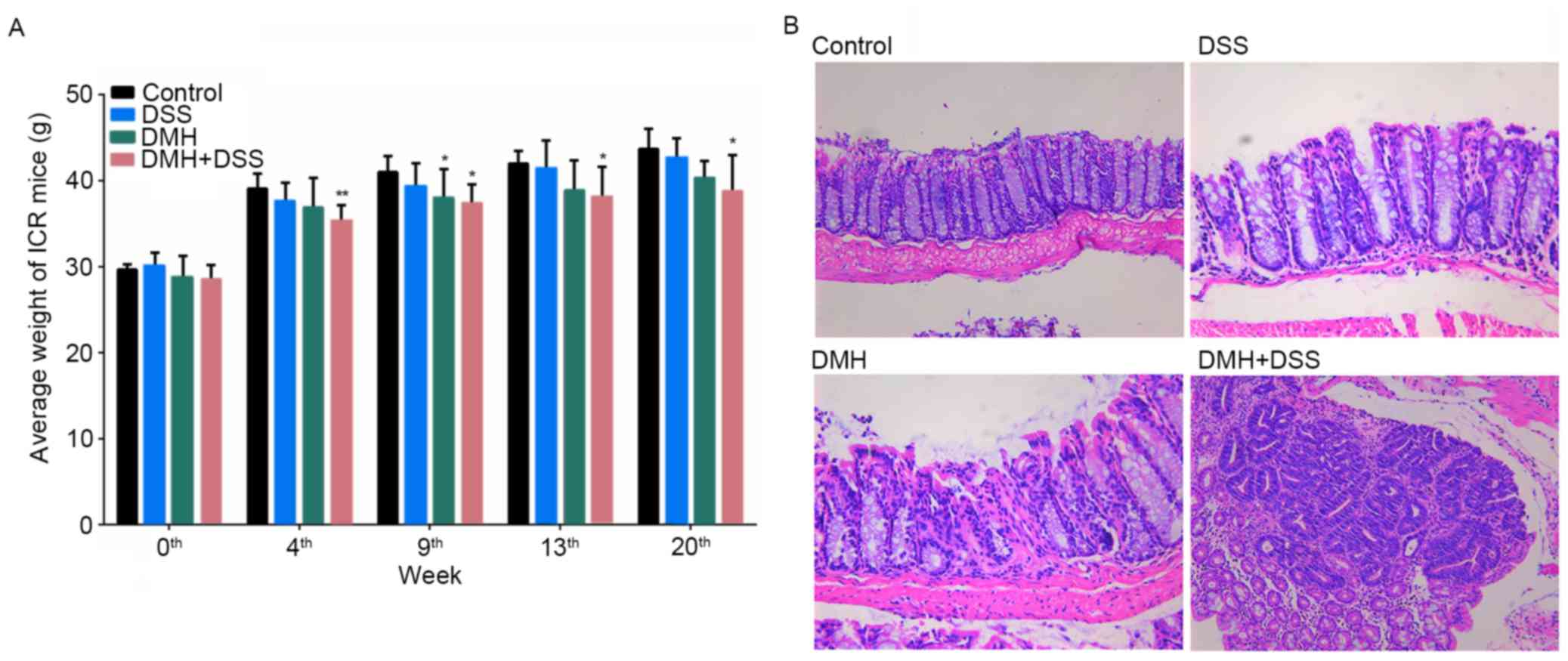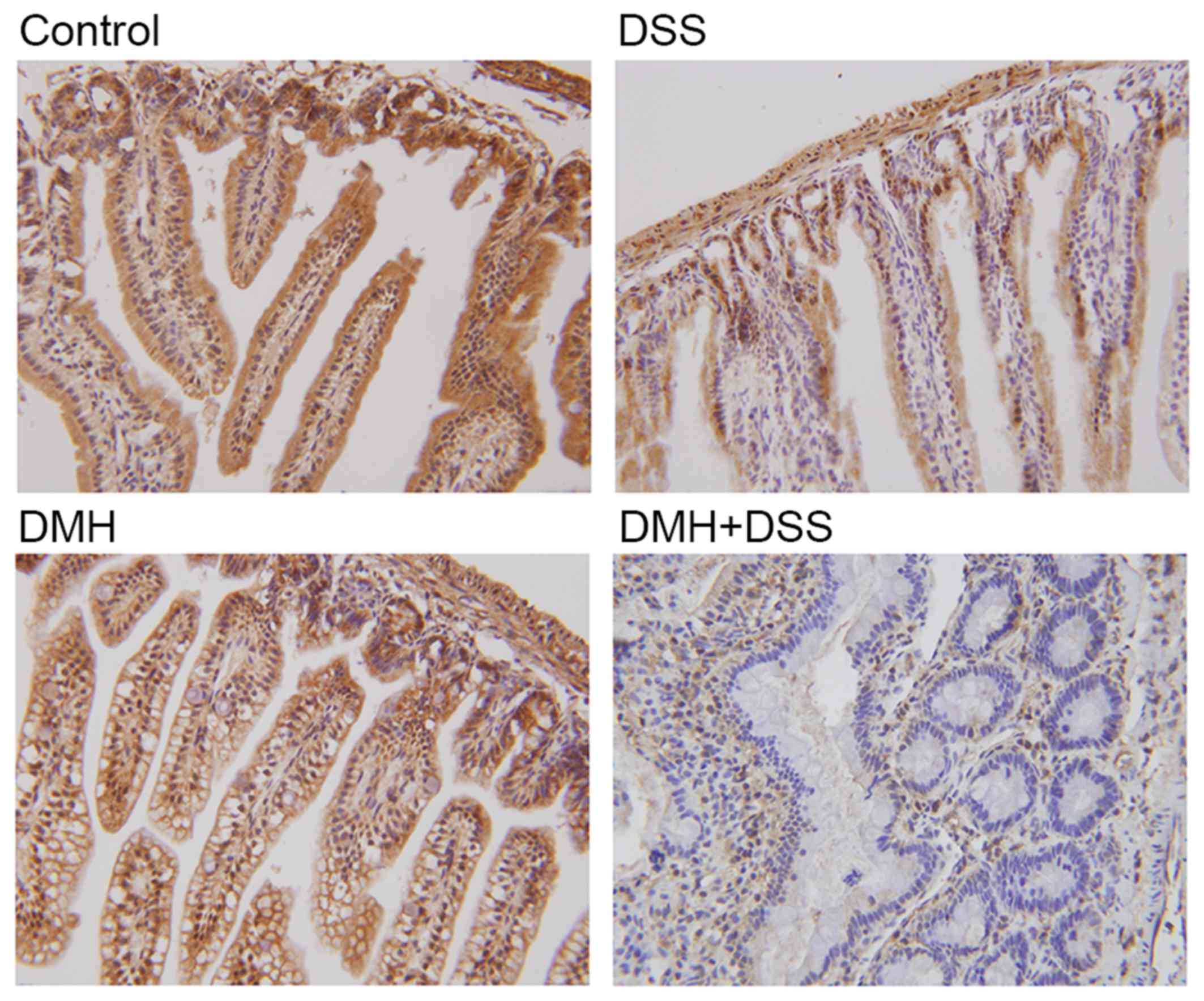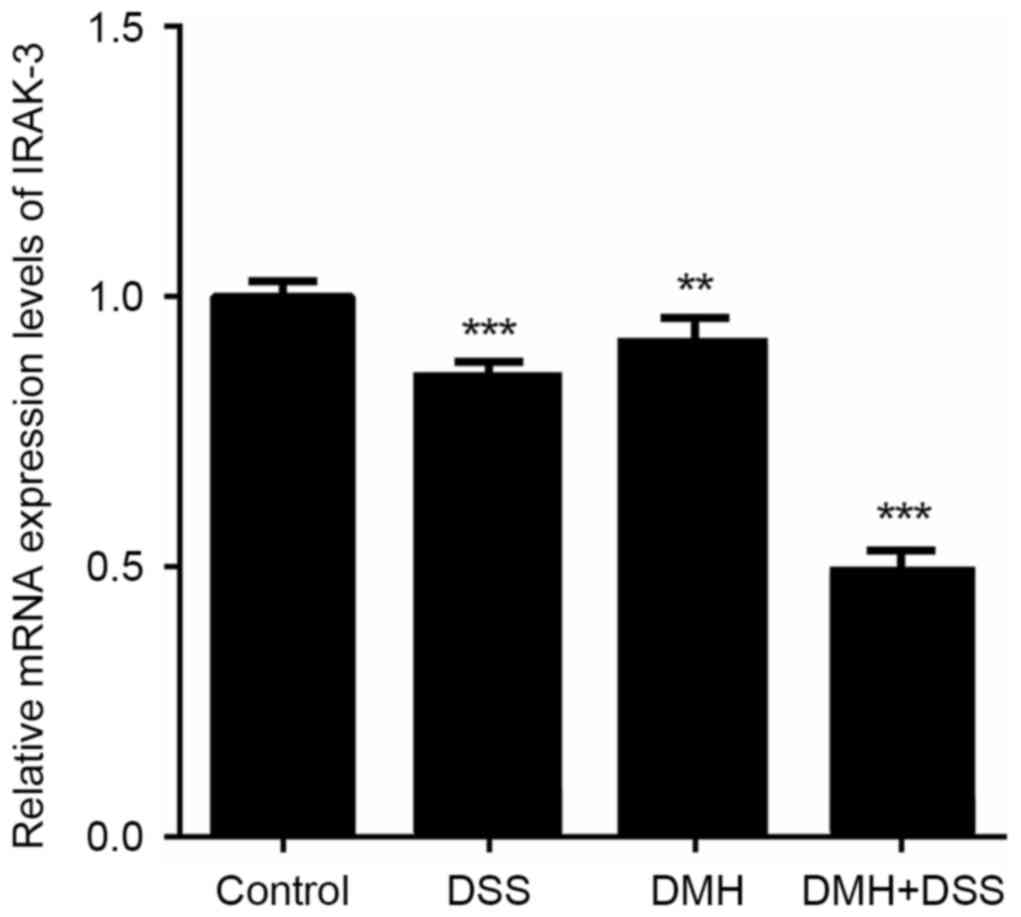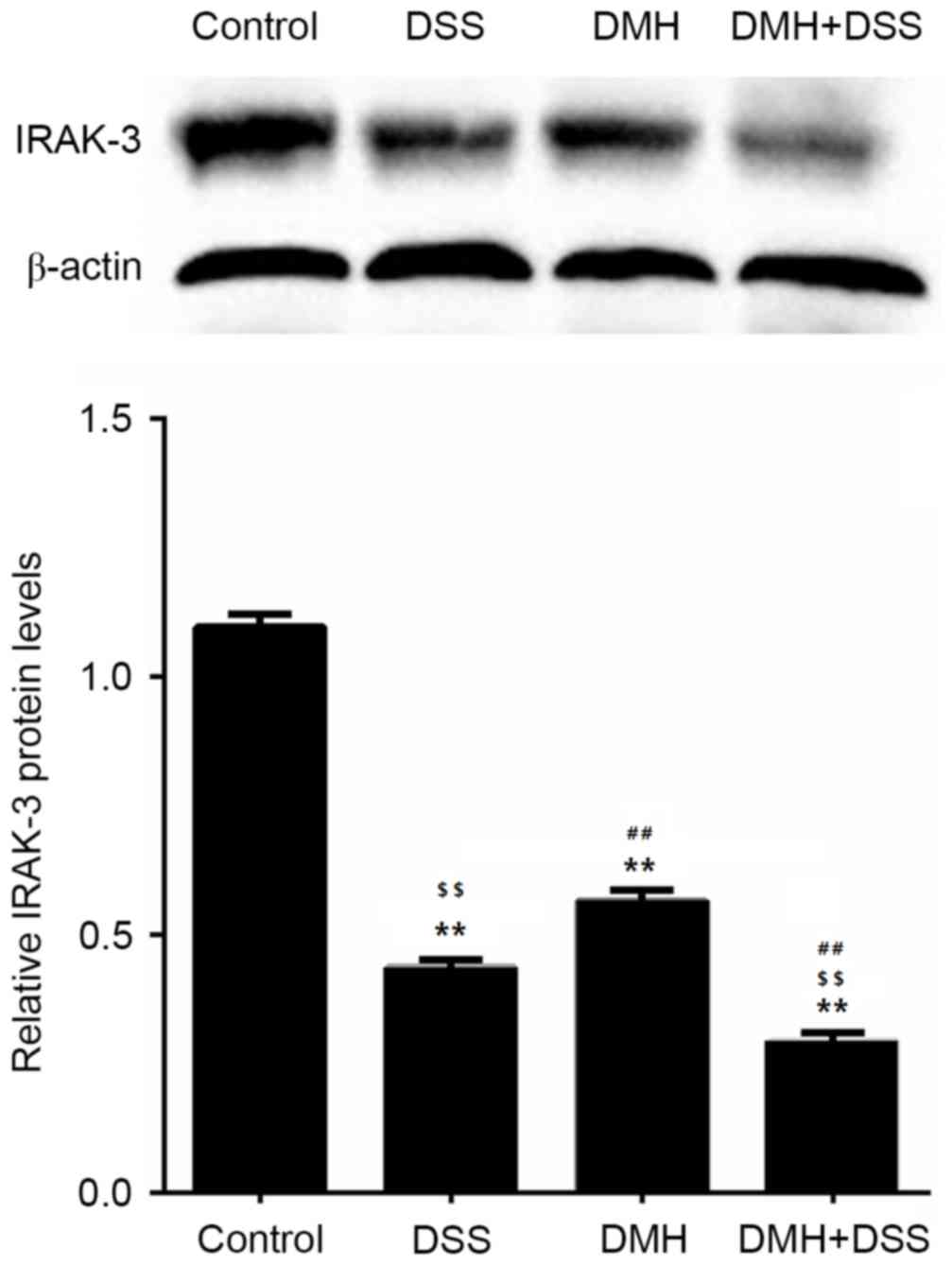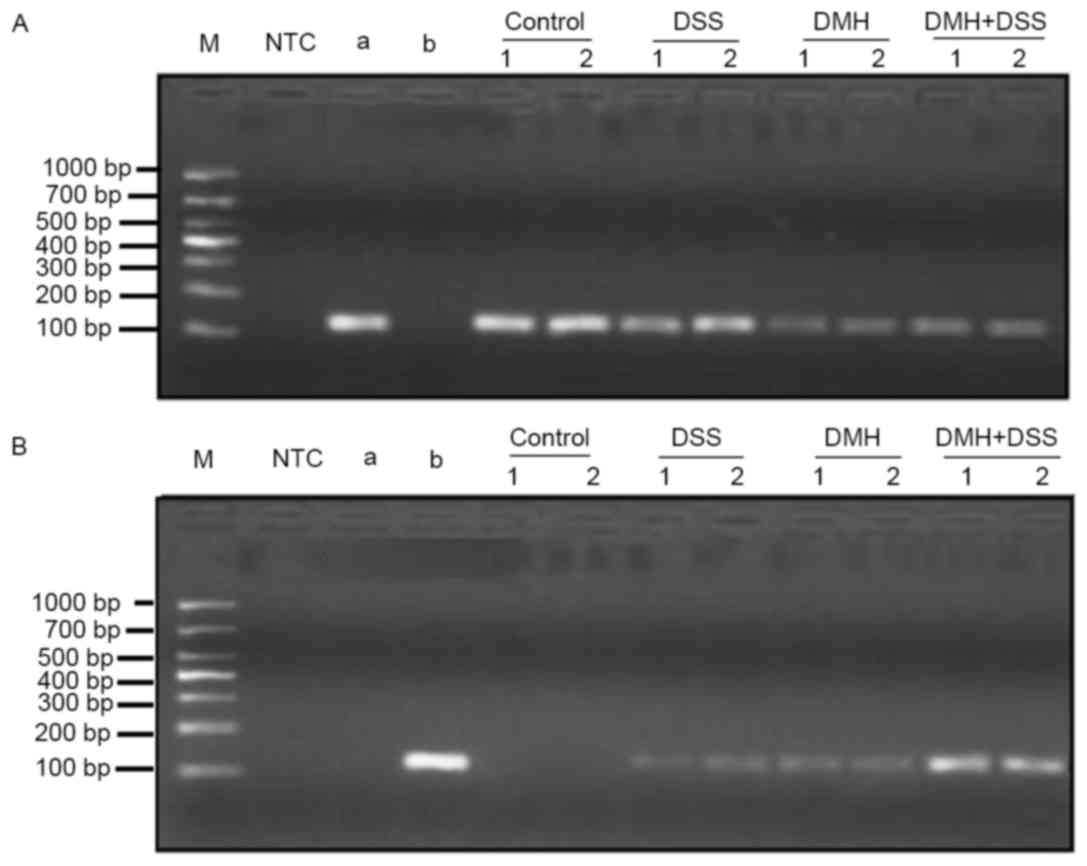Expression of IRAK‑3 is associated with colitis‑associated tumorigenesis in mice
- Authors:
- Published online on: July 12, 2017 https://doi.org/10.3892/mmr.2017.6958
- Pages: 3415-3420
Abstract
Introduction
Ulcerative colitis (UC) is a chronic condition characterized by continuous inflammation of the colonic mucosa and submucosa, and it is associated with an increased risk of colon, rectal and bowel cancer. A previous study reported that the worldwide incidence of UC was 1.2–20.3 cases per 100,000 individuals per year, with a prevalence of 7.6–246.0 cases per 100,000 individuals per year (1). UC is one of two conditions referred to as inflammatory bowel disease, the other condition being Crohn's disease.
Several animal models have been developed to investigate the pathogenesis of UC in detail. UC can be readily induced in animal models either chemically or by bacterial infection. The majority of animal models of UC involve mice; however, UC has previously also been induced in other animals, including zebrafish, Drosophila and pigs (2). The administration of dextran sulfate sodium, intrarectal administration of oxalozone or acetic acid, or infection with Salmonella typhimurium or Escherichia coli have all been successfully used to induce UC-like symptoms and immune responses in animal models. The interleukin (IL)-7 gene is a candidate risk gene associated with UC. T-cell receptor α chain (TCRα)-knockout mice have been reported to spontaneously develop chronic colitis, which was mediated by a Th2-type immune response closely resembling human UC, with an inflammatory pattern restricted primarily to the colonic mucosa. Thus, genetic approaches, including the knockout of IL-7 and TCRα genes have also been used to induce chronic colitis in animal models (3).
There is substantial evidence suggesting that UC-associated colon cancer is responsible for 10–15% of UC-associated mortality (4). However, how the chronic inflammation of UC develops into cancer remains to be elucidated.
Toll-like receptor (TLR) and innate immune processes have been shown to be involved in the pathogenesis of colitis-associated tumorigenesis (5). The expression of TLR4 has been found to be increased in colitis-associated tumorigenesis and is associated with the degree of dysplasia (2). IL-1 receptor-associated kinase (IRAK) and MyD88 are key factors involved in TLR4-associated signal transduction. IRAK-1 and IRAK-4 are the active members of the IRAK family, whereas IRAK-2 and IRAK-3, also known as IRAK-M, are the inactive members of this family. The expression of IRAK-3 is localized to the monocyte and macrophage populations only, and it prevents the formation of a complex containing IRAK-1 and IRAK-4. The other members of the IRAK family are ubiquitous. Studies have reported increased inflammation in IRAK-3−/− cells and mice, suggesting that IRAK-3 is a negative regulator in TLR pathways, whereas the lack of IRAK-3 is known to be associated with inflammation and tumorigenesis (6–8). Specifically, IRAK-3 mediates TLR7-induced MEKK3-dependent second wave activation of nuclear factor-κB (NF-κB) to produce inhibitory molecules as negative feedback in the pathway, and exerts an inhibitory effect on the translational control of cytokines and chemokines (9,10). Previous studies have also demonstrated that chronic inflammation is frequently accompanied by methylation in the development of UC, which occurs prior to dysplasia (11). Although the exact mechanism of methylation and its association with tumorigenesis remains to be elucidated, these findings indicate that the early detection of methylation may serve to predict and consequently prevent cancer.
Therefore, the present study aimed to determine the role of IRAK-3 and changes in its methylation levels in a mouse model of chemically induced colitis-associated cancer, in order to examine the potential of IRAK-3 as a therapeutic target.
Materials and methods
Animals
Male ICR mice (5 weeks old) weighing 25–33 g were purchased from the Shanghai Laboratory Animal Research Center (Shanghai, China; certificate no. SCXK2013-0016). Mice were maintained under standard conditions with a temperature of 24±1°C and 12-h light/dark cycle, and were fed standard laboratory chow and tap water ad libitum. The experiment was performed following 3 days of acclimatization. All procedures were performed in strict accordance with the legislation of the P.R China. The study was approved by the animal ethics committee of the Second Affiliated Hospital, School of Medicine, Zhejiang University (Hangzhou, China).
Development of the mouse model
The ICR mice were randomly allocated into four groups (n=8 mice/group). The mice in the control group were injected intraperitoneally with 200 µl physiological saline, whereas the mice in the DMH and DMH + DSS groups were injected intraperitoneally with 15 mg/kg 1,2-dimethyl hydrazine (DMH) dissolved in physiological saline (pH 6.5–7.0). After 1 week, the mice in the DSS and DMH + DSS groups were provided with 2% dextran sodium sulfate (DSS) dissolved in tap water, which was provided ad libitum for 7 days, whereas the mice in the control and DMH groups were provided with tap water ad libitum. The body weights, levels of activity and clinical signs of the mice were monitored every week for a period of 20 weeks. At weeks 4, 9, 13 and 20, one mouse from each group was sacrificed, and tissue samples were collected for histopathological examination. At week 20, the levels of IRAK3 were analyzed using immunohistochemistry, western blot analysis, reverse transcription-quantitative polymerase chain reaction (RT-qPCR) analysis and methylation-specific PCR (MSP) analysis.
Histological examination
For histological examination, one mouse from each group was sacrificed at weeks 4, 9, 13 and 20. The abdominal cavity of the mouse was opened, and the colon was isolated and generally scored. A 1-cm specimen was then cut at 3 cm from the anal verge, and placed in 40 g/l formalin at room temperature for 48 h. The specimens were embedded in paraffin and then cut into 4–7-µm-thick sections. The sections were stained with 2 g/l hematoxylin for 5 min and 0.5% eosin for 2–3 min at room temperature and examined under a light microscope.
Immunohistochemical analysis of IRAK-3
The immunohistochemical staining was performed using a standard avidin-biotin complex technique at week 20. The fresh frozen (4-µm-thick) sections of mice colon were mounted onto glass slides, fixed in 100% acetone for 10 min at 4°C, air-dried at room temperature for 10 min and rehydrated in PBS. Following blocking of endogenous peroxidase activity for 20 min in 3% hydrogen peroxide at room temperature, the slides were incubated for 10–15 min at room temperature with normal goat serum (Nanjing Jiancheng Bioengineering Institute, Nanjing, China) for blocking. The slides were then incubated with anti-IRAK3 antibodies (cat no. ab238; 1:1,500; Abcam, Cambridge, MA, USA) at 4°C overnight. The slides were then kept for 20–30 min at room temperature, washed in PBS and then incubated for 10–15 min at room temperature with a goat anti-rabbit horseradish peroxidase-conjugated secondary antibody (cat no. ab6721; 1:1,000; Abcam). Following washing with PBS, the slides were incubated with streptavidin-biotin complex (cat no. ab7403; 1:15,000; Abcam) for 30 min at room temperature, then washed in PBS 3 times and stained with diaminobenzidine (cat no. ab103723; Abcam) for 20 min at room temperature. Finally, the sections were rinsed in distilled water, counterstained with 2 g/l hematoxylin for 1 min at room temperature, washed in running tap water and mounted with mounting media. The slides were then observed under a light microscope (Olympus, Tokyo, Japan) and images were captured. Immunohistochemical data were quantified using Image-Pro Plus software version 6.0 (Media Cybernetics, Inc., Rockville, MD, USA).
RT-qPCR
The colon tissues were snap-frozen in liquid nitrogen, and stored at −80°C until further analysis. Colon tissues were homogenized in diethyl pyrocarbonate-treated water, ice-cold PBS, 70% ethanol and isopropyl alcohol, and total RNA was extracted using TRIzol® reagent (Invitrogen; Thermo Fisher Scientific, Inc., Waltham, MA, USA). Total RNA was reverse-transcribed into cDNA using RevertAid First Strand cDNA Synthesis (Thermo Fisher Scientific, Inc.). qPCR was performed on cDNA using a Toyobo Revertra Ace qRCR RT kit (Toyobo Co., Ltd., Osaka, Japan) and SYBR Green Real-Time PCR Master Mix (Thermo Fisher Scientific, Inc.). The qPCR reaction consisted of 25.0 µl SYBR Green Real-Time PCR Master Mix, 5.0 µl cDNA, 16.0 µl nuclease-free water, and 4.0 µl of primer pairs, all in a total volume of 50 µl. The thermocycling conditions were as follows: Initial denaturation at 95°C for 10 min, followed by 40 cycles at 95°C for 15 sec, at 60°C for 30 sec and at 72°C for 30 sec. The mRNA expression levels were normalized to GAPDH, which was used as the endogenous control. The following primer sequences were used: IRAK-3, forward 5′-TTGGTCCTGGGCACAGAAA-3′, reverse 5′-AATAGCTCGACGATGTCCCAT-3′; and GAPDH, forward 5′-GGTATCGTGGAAGGACTCATGAC-3′ and reverse 5′-ATGCCAGTGAGCTTCCCGTTCCCGTTCAGC-3′. Target gene expression was quantified according to the comparative Cq method (12). Experiments were performed in triplicate.
Western blot analysis
Total proteins were extracted from the colon samples obtained at week 20 using ice-cold radioimmunoprecipitation assay lysis buffer containing 50 mM Tris-HCl (pH 8.0), 150 mM sodium chloride, 1 mM EDTA (pH 8.0), 1% (v/v) TritonX-100, 0.1% (m/v) SDS and 1 mM phenylmethylsulfonyl fluoride. Protein concentration was determined using a Bradford assay. Equal amounts of extracted protein samples (20 µl) were separated by 10% SDS-PAGE and transferred onto a polyvinylidene difluoride membrane. The membrane was blocked with 5% nonfat dried milk in PBS containing 0.1% Tween-20 for 1 h at room temperature and then incubated with an anti-IRAK-3 (cat no. ab238; 1:5,000; Abcam) antibody at 4°C overnight, followed by incubation for 2 h at room temperature with goat anti-rabbit horseradish peroxidase-conjugated secondary antibodies [cat no. 70-GAR007; 1:10,000; Multisciences (Lianke) Biotech Co., Ltd., Hangzhou, China]. The protein bands were visualized and documented using the ChampGel™6000 image acquisition and analysis system (Beijing Sage Creation Science Co., Ltd., Beijing, China). Blots were semi-quantified using ImageJ software version 2.1.4.7 (National Institutes of Health, Bethesda, MD, USA).
Bisulfite modification and MSP analysis
Genomic DNA was isolated from colon tissues using the TIANamp Genomic DNA kit (Tiangen Biotech Co., Ltd., Beijing, China). Briefly, 1 µg genomic DNA was bisulfite-modified using an EZ DNA Methylation-Lightning™ kit (Zymo Research Corporation, Irvine, CA, USA) according to the manufacturer's protocol. The MSP was performed at 94°C for 5 min, followed by 35 cycles at 94°C for 30 sec, 55°C for 30 sec and 72°C for 30 sec. The final extension step was performed at 72°C for 10 min. The PCR reaction consisted of 1.5 µl 10X Taq Buffer, 1.0 µl dNTP (20 mM), 0.5 µl Taq DNA polymerase (Takara Bio, Inc., Otsu, Japan), 1.0 µl cDNA, 20.0 µl nuclease-free water and 1.0 µl primer pairs, in a total volume of 25 µl. The following MSP primer sequences were used: IRAK-3 unmethylated, forward 5′-AAGTAATTATGGATTGAAGTTTTGA-3′ and reverse 5′-CAAACAAAAACAACCTAAAACATA-3′, IRAK-3 methylated, forward 5′-AAGTAATTATGGATTGAAGTTTCGA-3′ and reverse 5′-CAAACAAAAACAACCTAAAACGTA-3′.
Statistical analysis
Data are expressed as the mean ± standard deviation for each group. An independent t-test was used to evaluate differences between two treatment groups. All data were processed and analyzed using SPSS version 19.0 (IBM Corp., Armonk, NY, USA). P<0.05 was considered to indicate a statistically significant difference.
Results
General condition and pathological evaluations
At weeks 9 and 13 following the start of the experiment, colitis was induced in the mice by injection with 15 mg/kg DMH (DMH and DMH + DSS groups) or by provision of drinking water containing 2% DSS for 7 days (DSS and DMH + DSS groups). At week 20, the mice in the DMH + DSS group had lost body weight and developed canalicular adenoma or adenocarcinoma (Fig. 1).
Immunohistochemical localization of IRAK-3 in the colon
Positive cytoplasmic and nuclear staining for IRAK-3 was found in all groups, and this positive staining was highest in the mice without DMH or DSS (Fig. 2). By contrast, positive staining for IRAK-3 was minimal in the colitis-associated cancer model. The quantitative results of the immunohistochemistry also showed that the expression of IRAK-3 in the colon was decreased significantly in the mice with induced colitis, particularly in the mice with tumorigenesis (P=0.000; Table I). Taken together, the results of the immunohistochemistry indicated that IRAK-3 was downregulated in the colon cells of DSS- or DMH-induced colitis, particularly in the colitis-associated cancer model.
Expression levels of IRAK-3 and gene methylation in the colon
The gene expression of IRAK-3 in the colon was significantly lower in mice in the DMH + DSS group with colitis-associated tumorigenesis (P<0.001; Fig. 3). The results of the western blot analysis also revealed that the protein levels of IRAK-3 in the colon were decreased in mice with induced colitis, particularly in mice with tumorigenesis (Fig. 4), which was in line with the results of the mRNA levels of IRAK-3. Methylation of the IRAK-3 gene was observed in the DSS, DMH and DMH + DSS groups. However, the methylation levels were higher in the mice in the DMH + DSS group, compared with those in the other two groups (Fig. 5).
Discussion
Patients with UC are at an increased risk of colorectal cancer (4). TLR and innate immune processes are involved in the pathogenesis of UC-associated tumorigenesis. As the role of IRAK-3 as a negative regulator in TLR pathways is well known, the present study investigated the importance of IRAK-3 in a chemically-induced model of colitis-associated tumorigenesis in mice. Colonic epithelial cells and microbes are important components of the gut barrier. Damage to colonic epithelial cells can induce inflammation and, if the inflammation is aggravated, it increases the risk of cancer (11). DMH and DSS are widely used to induce colitis in murine models (13,14). Therefore, these two agents were used in the present study to establish a murine UC model.
The mice in the present study were administered with physiological saline, DMH, DSS, or DMH + DSS, and the expression levels of IRAK-3 were analyzed. IRAK-3 was expressed in all groups, and the positive staining for IRAK-3 was highest in the mice without DMH or DSS (Fig. 2). IRAK-3 generally acts as a negative regulator of the activation of NF-κB, IRAK-4/IRAK-1 and IRAK-4/IRAK-2 in TLR and IL-1R signaling, and favors immunosuppression (6–8,15). Jain et al (7) demonstrated that types of cancer with reduced levels of IRAK-3, but elevated levels of IRAK-1, IRAK-2, and/or IRAK-4, showed increased IRAK-4 signaling and consequently elevated levels of inflammatory molecules. The absence of IRAK-3 may further sustain IRAK-4 signaling and perpetuate a chronically inflamed tumor environment; chronic inflammation is a hallmark of tumorigenesis and tumor progression (16). Several studies have supported the conclusion that the negative regulation of IRAK-4 is important in colon cancer resistance (17). The results of the present study showed similar results in the colitis mice model. It was found that colitis and dysplasia specimens showed decreased expression of IRAK-3. However, a previous study showed that IRAK-3 may promote cancer progression by modulating macrophage activity (7). Evidence from previous studies using in vivo mouse models showed that the expression level of IRAK-3 was higher in infiltrating macrophages, and that the expression levels of IRAK-3 in the tumor cells of patients with lung cancer were significant and independent predictors of mortality rates (18–20). These data suggest that the role of IRAK-3 remains to be fully elucidated. It may be a regulator between tumor cells and macrophages, which may prevent or promote tumorigenesis, particularly in UC. Further investigations are warranted to examine the role of IRAK-3, and its methylated form, in UC and colon cancer.
During the course of chronic inflammation, various genes undergo methylation, including, E-cadherin (21) and hyperplastic polyposis protein 1 (HPP1) (22). CpG island hypermethylation has also been reported to occur in relation to tumorigenesis or aging. A study on nonneoplastic gastric mucosa reported that chronic inflammation is closely associated with increased methylation (23,24). In a previous study, the methylation of E-cadherin was found in 93% of dysplasia specimens; HPP1 was considered to be associated with the adenoma (polyp) cancer path, and methylation was found in 50% of colitis-associated cancer cases and 40% of dysplasia cases. The degree of methylation is connected with the level of inflammation (25). Ullman and Itzkowitz (11) suggested that DNA methylation occurs prior to dysplasia. These findings indicate that methylation may be a potential target for clinical intervention. The present study further investigated whether IRAK-3 is methylated, and determined the significance of this change. The results showed that IRAK-3 was methylated in the cancer chemically-induced colitis groups, supporting the hypothesis that the expression and methylation of IRAK-3 may be involved in UC and subsequent tumorigenesis. However, to examine the effect of IRAK-3 on tumorigenesis, experiments involving the knock down of the IRAK-3 gene or siRNA are required.
The present study had a number of limitations. T cells and B cells are not required for the development of chemically-induced colitis; therefore, the mouse models may not be an accurate reflection of human colitis. In addition, intestinal bacteria are important in the development of colitis. Further investigations should take these factors into account when establishing animal models of colitis.
In conclusion, the present study demonstrated the expression of IRAK-3 and gene methylation of IRAK-3 in the colons of mice with chemically-induced UC. The results revealed that DSS and DMH induced the downregulation of IRAK-3 and methylation of a region of IRAK-3, increased inflammation in the colon, and increased the risk of tumorigenesis. Together, these findings suggested that IRAK-3 gene methylation may be a predictive factor in the transition from colitis to cancer, and IRAK-3 may be a potential therapeutic target for colitis and tumorigenesis.
Acknowledgements
The present study was supported by the Science and Technology Project of Zhejiang Province, China (grant no. 2012C37105) and the Natural Science Foundation of Zhejiang Province, China (grant no. LY15H160040).
References
|
Danese S and Fiocchi C: Ulcerative colitis. N Engl J Med. 365:1713–1725. 2011. View Article : Google Scholar : PubMed/NCBI | |
|
Low D, Nguyen DD and Mizoguchi E: Animal models of ulcerative colitis and their application in drug research. Drug Des Devel Ther. 7:1341–1357. 2013.PubMed/NCBI | |
|
Mombaerts P, Mizoguchi E, Grusby MJ, Glimcher LH, Bhan AK and Tonegawa S: Spontaneous development of inflammatory bowel disease in T cell receptor mutant mice. Cell. 75:274–282. 1993. View Article : Google Scholar : PubMed/NCBI | |
|
Eaden JA, Abrams KR and Mayberry JF: The risk of colorectal cancer in ulcerative colitis: A meta-analysis. Gut. 48:526–535. 2001. View Article : Google Scholar : PubMed/NCBI | |
|
Fukata M, Shang L, Santaolalla R, Sotolongo J, Pastorini C, España C, Ungaro R, Harpaz N, Cooper HS, Elson G, et al: Constitutive activation of epithelial TLR4 augments inflammatory responses to mucosal injury and drives colitis-associated tumorigenesis. Inflamm Bowel Dis. 17:1464–1473. 2011. View Article : Google Scholar : PubMed/NCBI | |
|
Biswas A, Wilmanski J, Forsman H, Hrncir T, Hao L, Tlaskalova-Hogenova H and Kobayashi KS: Negative regulation of Toll-like receptor signaling plays an essential role in homeostasis of the intestine. Eur J Immunol. 41:182–194. 2011. View Article : Google Scholar : PubMed/NCBI | |
|
Jain A, Kaczanowska S and Davila E: IL-1 receptor-associated kinase signaling and its role in inflammation, cancer progression, and therapy resistance. Front Immunol. 5:5532014. View Article : Google Scholar : PubMed/NCBI | |
|
Berglund M, Melgar S, Kobayashi KS, Flavell RA, Hörnquist EH and Hultgren OH: IL-1 receptor-associated kinase M downregulates DSS-induced colitis. Inflamm Bowel Dis. 16:1778–1786. 2010. View Article : Google Scholar : PubMed/NCBI | |
|
Zhou H, Yu M, Fukuda K, Im J, Yao P, Cui W, Bulek K, Zepp J, Wan Y, Kim TW, et al: IRAK-M mediates Toll-like receptor/IL-1R-induced NFκB activation and cytokine production. EMBO J. 32:583–596. 2013. View Article : Google Scholar : PubMed/NCBI | |
|
Kobayashi K, Hernandez LD, Galán JE, Janeway CA Jr, Medzhitov R and Flavell RA: IRAK-M is a negative regulator of Toll-like receptor signaling. Cell. 110:191–202. 2002. View Article : Google Scholar : PubMed/NCBI | |
|
Ullman TA and Itzkowitz SH: Intestinal inflammation and cancer. Gastroenterology. 140:1807–1816. 2011. View Article : Google Scholar : PubMed/NCBI | |
|
Livak KJ and Schmittgen TD: Analysis of relative gene expression data using real-time quantitative PCR and the 2(−Delta Delta C(T)) Method. Methods. 25:402–408. 2001. View Article : Google Scholar : PubMed/NCBI | |
|
Tanaka T, Kohno H, Suzuki R, Yamada Y, Sugie S and Mori H: A novel inflammation-related mouse colon carcinogenesis model induced by azoxymethane and dextran sodium sulfate. Cancer Sci. 94:965–973. 2003. View Article : Google Scholar : PubMed/NCBI | |
|
Okayasu I, Hatakeyama S, Yamada M, Ohkusa T, Inagaki Y and Nakaya R: A novel method in the induction of reliable experimental acute and chronic ulcerative colitis in mice. Gastroenterology. 98:694–702. 1990. View Article : Google Scholar : PubMed/NCBI | |
|
Chen W, Saxena A, Li N, Sun J, Gupta A, Lee DW, Tian Q, Dobaczewski M and Frangogiannis NG: Endogenous IRAK-M attenuates postinfarction remodeling through effects on macrophages and fibroblasts. Arterioscler Thromb Vasc Biol. 32:2598–2608. 2012. View Article : Google Scholar : PubMed/NCBI | |
|
Hanahan D and Weinberg RA: Hallmarks of cancer: The next generation. Cell. 144:646–674. 2011. View Article : Google Scholar : PubMed/NCBI | |
|
Klimesova K, Kverka M, Zakostelska Z, Hudcovic T, Hrncir T, Stepankova R, Rossmann P, Ridl J, Kostovcik M, Mrazek J, et al: Altered gut microbiota promotes colitis-associated cancer in IL-1 receptor-associated kinase M-deficient mice. Inflamm Bowel Dis. 19:1266–1277. 2013. View Article : Google Scholar : PubMed/NCBI | |
|
del Fresno C, Otero K, Gómez-García L, González-León MC, Soler-Ranger L, Fuentes-Prior P, Escoll P, Baos R, Caveda L, García F, et al: Tumor cells deactivate human monocytes by up-regulating IL-1 receptor associated kinase-M expression via CD44 and TLR4. J Immunol. 174:3032–3040. 2005. View Article : Google Scholar : PubMed/NCBI | |
|
Soares-Schanoski A, Jurado T, Córdoba R, Siliceo M, Fresno CD, Gómez-Piña V, Toledano V, Vallejo-Cremades MT, Alfonso-Iñiguez S, Carballo-Palos A, et al: Impaired antigen presentation and potent phagocytic activity identifying tumor-tolerant human monocytes. Biochem Biophys Res Commun. 423:331–337. 2012. View Article : Google Scholar : PubMed/NCBI | |
|
Standiford TJ, Kuick R, Bhan U, Chen J, Newstead M and Keshamouni VG: TGF-β-induced IRAK-M expression in tumor-associated macrophages regulates lung tumor growth. Oncogene. 30:2475–2484. 2011. View Article : Google Scholar : PubMed/NCBI | |
|
Wheeler JM, Kim HC, Efstathiou JA, Ilyas M, Mortensen NJ and Bodmer WF: Hypermethylation of the promoter region of the E-cadherin gene (CDH1) in sporadic and ulcerative colitis associated colorectal cancer. Gut. 48:367–371. 2001. View Article : Google Scholar : PubMed/NCBI | |
|
Sato F, Shibata D, Harpaz N, Xu Y, Yin J, Mori Y, Wang S, Olaru A, Deacu E, Selaru FM, et al: Aberrant methylation of the HPP1 gene in ulcerative colitis-associated colorectal carcinoma. Cancer Res. 62:6820–6822. 2002.PubMed/NCBI | |
|
Kang GH, Lee HJ, Hwang KS, Lee S, Kim JH and Kim JS: Aberrant CpG island hypermethylation of chronic gastritis, in relation to aging, gender, intestinal metaplasia, and chronic inflammation. Am J Pathol. 163:1551–1556. 2003. View Article : Google Scholar : PubMed/NCBI | |
|
Jang TJ, Kim DI, Shin YM, Chang HK and Yang CH: p16(INK4a) Promoter hypermethylation of non-tumorous tissue adjacent to gastric cancer is correlated with glandular atrophy and chronic inflammation. Int J Cancer. 93:629–634. 2001. View Article : Google Scholar : PubMed/NCBI | |
|
Saito S, Kato J, Hiraoka S, Horii J, Suzuki H, Higashi R, Kaji E, Kondo Y and Yamamoto K: DNA methylation of colon mucosa in ulcerative colitis patients: Correlation with inflammatory status. Inflamm Bowel Dis. 17:1955–1965. 2011. View Article : Google Scholar : PubMed/NCBI |



